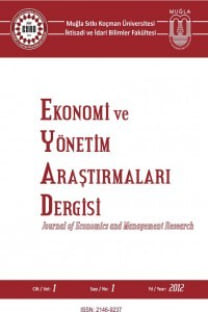ÇOK KRİTERLİ KARAR VERME TEKNİKLERİNİN HATA MODU VE ETKİLERİ ANALİZİNDE KULLANIMI
Hata Modu ve Etkileri Analizi, AHP, PROMETHEE, Risk Değerlendirme
THE USAGE OF MCDM TECHNIQUES IN FAILURE MODE AND EFFECT ANALYSIS
Failure Mode and Effect Analysis, AHP, PROMETHEE, Risk Assessment,
___
- Avikal, S., Mishra, P.K. and Jain, R. (2013), A Fuzzy AHP and Promethee Method-Based Heuristic for Disassembly Line Balancing Problems, International Journal of Production Research, Vol: 51
- Braglia, M. (2000), MAFMA: Multi-Attribute Failure Mode Analysis, International Journal Of Quality & Reliability Management, Vol:17
- Bruno, G., Esposito, E., Genovese, A. and Passaro, R. (2009), The Analytic Hierarcy Process in the Supplier Selection Problem, Proceedings of 10th Annual International Symposium on Analytic Hierarchy Process, Pittsburgh, ABD
- Chang, K., H. (2009), Evaluate the Ordering os Risk for Failure Problems Using a More General RPN Methodology, Microelectronics Reliability, Vol: 49
- Chen, K., J. and Lee, Y., C. (2007), Risk Priority Evaluated by ANP in Failure Mode and Effect Analysis, Quality Tolls and Techniques, Vol: 4
- Chen, H., Y., Wang, C., T. and Wu, Y., C. (2011), Strategic Decisions Using the Fuzzy PROMETHEE for IS Outsourcing, Expert Systems With Application, Vol: 38
- Chin, K., S., Wang, M., W., Poon, G., K., K. and Yang, J., B. (2009), Failure Mode and Effect Analysis by Data Envelopment Analysis. Decision Support Systems, Vol: 8
- Hu, A., H., Hsu, C., W., Kuo T., C. and Wu, W., C. (2009), Risk Evaluation of Green Components to Hazardous Substance Using FMEA and FAHP, Expert Systems with Applications, Vol: 36
- Kutlu, A., C. and Ekmekçioğlu, M. (2012), Fuzzy Failure Modes and Effect Analysis by Using Fuzzy TOPSIS-Based Fuzzy AHP, Expert System with Applications, Vol: 39
- Liu H., C., Liu, L. and Mao, X., L. (2012), Risk Evaluation in Failure Mode and Effect Analysis with Extended VIKOR Method Under Fuzzy Environment. Expert Systems with Applications, Vol: 39
- Maheswaran, K. and Loganathan, T. (2013), A Novel Approach for Prioritizaton of Failure Modes in FMEA Using MDCM, International Journal of Engineering Research and Applications, Vol:3
- Ömürbek, N., Üstündağ, S. and Helvacıoğlu Ö., C. (2013), Kuruluş Yeri Seçiminde Analitik Hiyerarşi Süreci (AHP) Kullanımı: Isparta Bölgesi’nde Bir Uygulama,Yönetim Bilimleri Dergisi, Sayı: 21
- Öztekin, C. (2006), Hizmet Sektöründe Hata Türü Etkileri Analizi ve Bir Uygulama, Unpublished Master Thesis, Marmara University Institute of Social Sciences, İstanbul
- Pillay, A. and Wang, J. (2003), Modified Failure Mode and Effect Analysis Using Approximate Reasoning, Reliability Engineering and System Safety, Vol: 79 Saaty, T., L. (1980), The Analytic Hierarchy Process, McGraw-Hill, ABD
- Saaty, T., L. (1987), The Analytic Hierarchy Process – What It is and How It is Used, Mathematical Modelling, Vol: 9
- Sofyalıoğlu, Ç. (2011), Grey Evaluation Model of Process Failure Mode Effect Analysis. Ege Akademik Bakış, Vol: 1
- Taillandier, P. and Stinckwich, S. (2011), Using the Promethee Multi Criteria Decision Making Method to Define New Exploration Strategies for Rescue Robots, IEEE International Symposium on Safety, Security and Rescue Robotics, 1-5 November, Kyoto, Japan
- Tay M., K. and Lim C., P. (2006), Fuzzy FMEA with a Guided Rules Reduction System for Prioritization of Failures, Internatioal Journal of Quality & Reliability Management, Vol: 23
- Vencheh, A., H., Hejazi, S. and Eslamiasab, Z. (2013), A Fuzzy Lineer Programming Model for Risk Evaluation in Failure Mode and Effect Analysis, Neural Comput & Applic, Vol: 22
- Wang Y., M., Chin K., S., Poon, G., K., K. and Yang, J., B. (2009), Risk Evaluation in Failure Mode and Effect Analysis Using Weighted Geometric Mean, Expert Systems with Applications, Vol: 36
- Yılmaz, B. and Dağdeviren, M. (2010), Comparative Analysis of PROMETHEE and Fuzzy PROMETHEE Methods in Equipment Selection Problem, Gazi Üniversitesi Mühendislik ve Mimarlık Fakültesi Dergisi, Vol:25
- ISSN: 2146-9237
- Başlangıç: 2012
- Yayıncı: Mugla Sitki Kocman University
Süleyman BARUTÇU, Deniz ÜNAL ADIGÜZEL
KONAKLAMA İŞLETMELERİNDE MUTFAKTA İSTİHDAM EDİLENLERİN TÜKENMİŞLİK SENDROMU: MARMARİS ÖRNEĞİ
Gülay HIZ, Aslı KARATAŞ, Ferah ÖZTEKİN ULUKSAR
TRAFİK HİZMETLERİNDE YEREL YÖNETİMLERİN ROLÜ
Rafet ÇEVİKBAŞ, Fatih Hakan DOĞAN
ÇOK KRİTERLİ KARAR VERME TEKNİKLERİNİN HATA MODU VE ETKİLERİ ANALİZİNDE KULLANIMI
